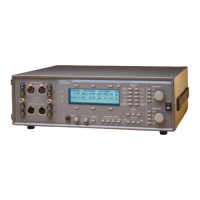Trigger Outputs
There are two trigger outputs provided on the rear panel of the ATS-1
Dual Domain. One is marked ANALOG, the other DIGITAL.
The analog trigger output provides a constant amplitude 1.0 Volt RMS
sinewave that is synchronized to the analog generator output signal. In
IMD generator mode, the signal is synchronous with the lower-
frequency tone.
The analog trigger output is intended primarily to provide a stable
trigger for oscilloscope displays of the monitor signals. The source
impedance for this signal is 680 Ω.
The digital trigger output can provide a variety of trigger signals from
the digital generator and analyzer. The signal is selected on the Setup
Panel. The signal has a high state of approximately 500 mV.
There are eight digital trigger options available:
.
RCV FRAME - The falling edge of the trigger signal will occur
on the channel 1 preamble of the signal on the digital analyzer
input and the rising edge will occur on the channel 2 preamble.
The trigger output will go through a complete cycle every frame.
.
RCV CLOCK - The trigger signal will be a square wave with a
period of 1/2 UI synchronized to the signal on the digital
analyzer input.
.
JIT GEN - The trigger signal will be a square wave synchronized
to the jitter generator signal.
.
DGEN WFM - The trigger signal will be a square wave
synchronized to the audio waveform embedded in the digital
signal.
.
RCV ERROR - The trigger signal will be normally low, but will
go high whenever the digital receiver’s Confidence, Lock,
Coding, or Parity flag is set.
.
REF FRAME - The falling edge of the trigger signal will occur on
the channel 1 preamble of the signal on the reference input and
the rising edge will occur on the channel 2 preamble. The
trigger output will go through a complete cycle every frame.
3 Operation
Operational Overview Generator Output and Analyzer Input connectors
ATS-1 Dual Domain User's Manual 3-37

